Two circles, one within the other, of hands holding, waves crashing behind us. An ocean joyous for the arrival of the native teens of the Klamath River basin. Sweaty palms, squeezing tighter at the words of a Requa elder defining their journey as one of medicine. For 310 miles, the youth of Paddle Tribal Waters had spread healing with each paddle stroke down the Klamath River. A feat these remarkable and talented youth have been preparing and training for since 2022.
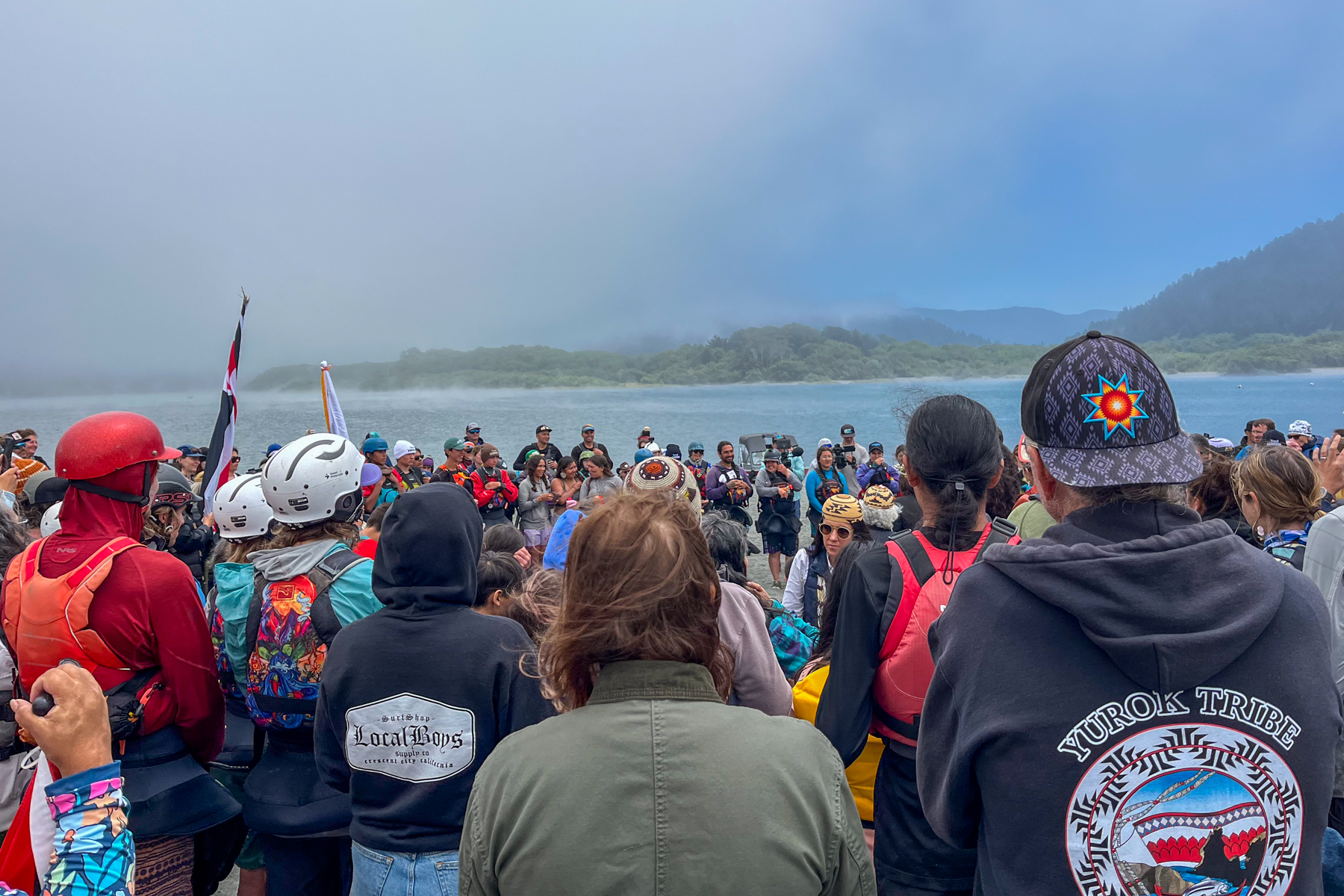
It was the passion the youth exuded about their culture that first drew me in. I come from a small desert town in Northern Arizona, a young Diné woman from the Western region of the Navajo Nation. Growing up near the Colorado River and Glen Canyon Dam has led my personal and professional work to focus on the rupturing impacts the dam has manifested in my communities and the land it has devastatingly flooded.
Being a little desert southwest native, I was eager to spend river time (the most potent time for connection, in my opinion) with my new community of coastal natives, joining the PTW crew for the last two weeks of their source-to-sea odyssey. Here was the chance to see the opposite. A land and people given the chance to heal.
Upon my arrival, the sense of welcoming, a feeling synonymous with Indigenous communities, was abundant. I work with Native youth across the Colorado Plateau, and was inspired to see the passion for culture continue I got to know these youth from the Klamath River basin. My heart grew while sharing my first meal under the trees with the group. I listened to each youth, in their native language, tell the story of who they are and where they come from, the tradition of introduction we carry on from our ancestors. That night, I went to bed dreaming of the acorn stories embedded in this land and its people.
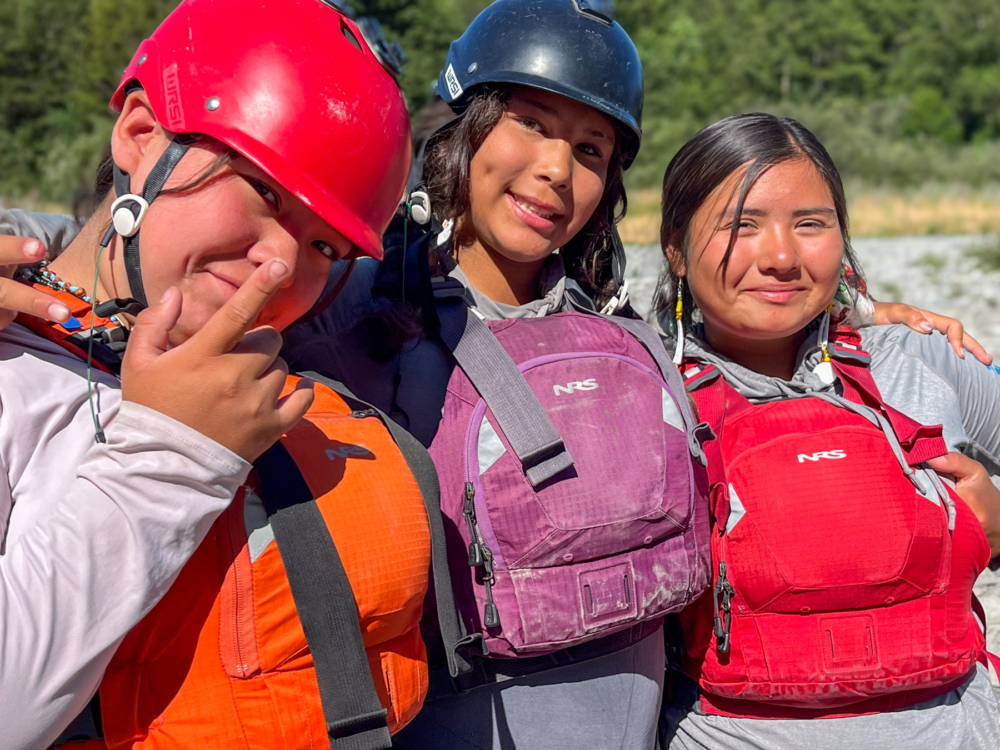

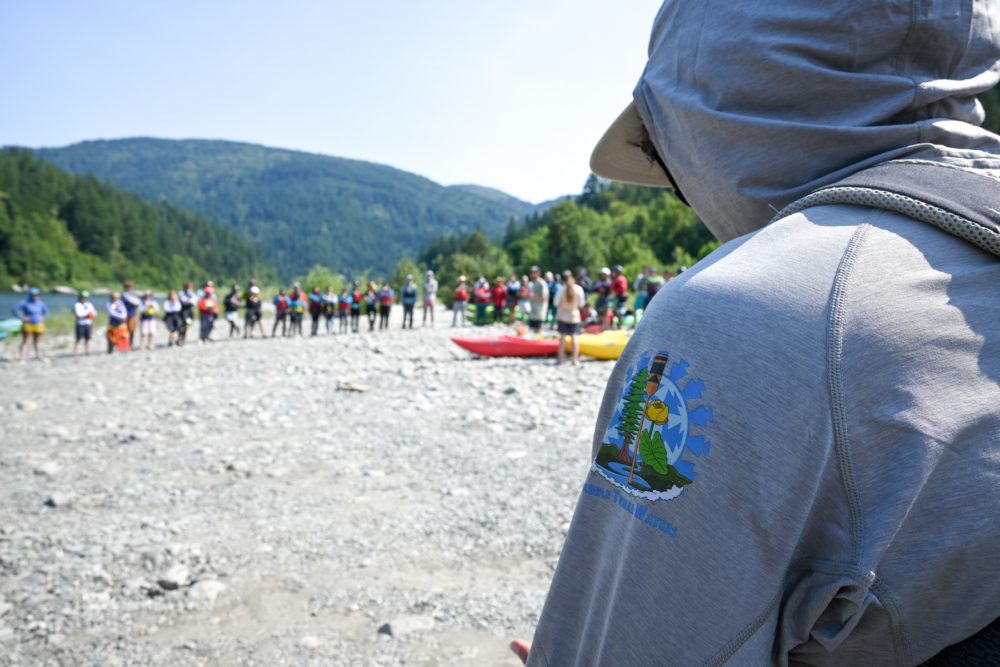
While the world watched in awe of the youth online, behind the scenes, the trip was in flux. Each day was a new problem to solve, fitting for an expedition of this magnitude. Thirty-one days of the wake-up, pack up, and paddle down. Our only constant was laughter. The newly restored current carried more than boats downstream, the physical and mental endurance of the long days rewarded by the cultural meaning and support behind the paddling.
The Klamath River has survived decades of trauma from unrelenting extraction and commodification, a tactic of settler colonialism that has poisoned most of the Western United States. Humor paired with prayer and blessings—communal and personal—to bring healing to land and people. Joking and teasing lasted from sunup to long after sundown, our laughter powerful medicine. A familiar tool that we, as Indigenous peoples, intrinsically tie to our fights for justice.
If humor was the undercurrent reason and result of the trip, cross-cultural connection became a primary thread that wove our group together. The youth offered teachings and blessings from all their cultures. Hoopa, Karuk, Yurok, Klamath, and Confederated Tribes of Warm Springs, to name a few. My first day on the water was embellished by cultural exchange, and each day followed suit.




It was a community float day, with dozens of kayaks and a handful of rafts filled with parents and siblings. I was honored to row Hoopa elder Clarence down the sacred stretch of river from Aikens Creek to Weitchpec. Before putting on the water, Clarence told an infamous story about First Grandmother. He shared the significance of this old village site and the six-mile stretch of river we were to float that day. A storytelling practice to honor the knowledge held in the land and river.
We floated with the sun above, clear water below, something my muddy river-self had some getting used to. Clarence told the stories of each rock and ridge we passed, and for hours, we four—Clarence, myself, and two of the PTW youth— traded songs and stories. Our ways of knowing passed through the wind and water.
The last four days of the descent, Indigenous brothers and sisters from Chile, Bolivia, China, and New Zealand joined us on the sacred grounds of Sregon Village. A true gathering of Nations from numerous Western tribes and Indigenous people from around the globe. Our ways of knowing expanded. Misty evenings filled with storytelling symbolically delineated how we all fight for the health of our rivers, even across continents. It is a fight that has been ongoing for generations in the Klamath River basin, successfully pushed forward by Indigenous communities.

At the Village of Ah-Pah, our host’s sister told the youth with tears in her eyes how she wished her mother could see the river’s health now. She was the first, but not the last, to look the youth in the eye and remind them that they are the answer to their ancestors’ prayers.
“Cherish your role, your part in the Klamath dam removal story,” she instructed, because so many of their family members who fought before them are not alive in the physical world to celebrate this monumental moment.
The Klamath is a beginning. For the seven generations to come, we persist in undoing the wrath of systemic oppression. One dam at a time, one river at a time. A movement displaying Indigenous resilience is healing for the people and the land, because they are one and the same. These youth are committed to social and environmental justice not because they necessarily want to, but because they must. In this way, their paddling became poetically radical.
This resiliency among the youth, among Indigenous peoples everywhere, is not a trait we chose to excel in. Truthfully, it’s a survival mechanism built up from our constant battles against social and environmental injustices and the legacies of genocide. The relatives of the PTW youth did not wish for their grandchildren to have to continue the same fight, and I know the descendants of the PTW youth deserve a life in which they don’t have to fight for their land, their water and their human rights.
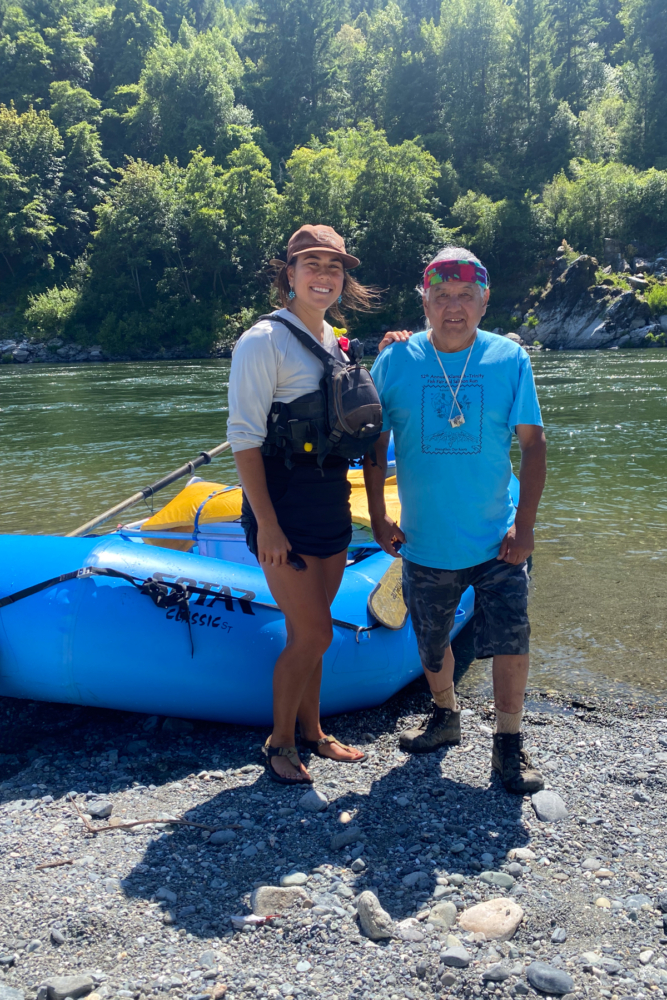
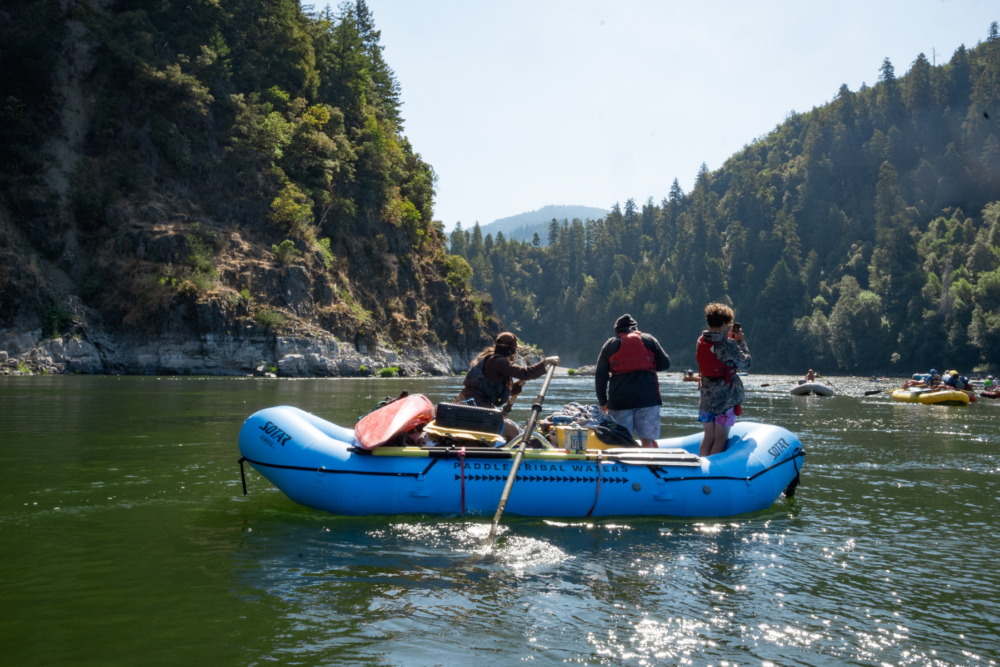
The days passed, the morning fog teasing our nearness to the sea. As support raft, one of my roles became the coat closet. My ear-infected passengers (daily kayak rolls will do it to ya) and I reluctantly took on piles of hoodies over increasingly chilly mornings. For the bigger picture, of course.
This close to the mouth, the river became the epitome of an environment given a chance to heal. Conversations bounced between boats, filled with excited disbelief at the positive changes. Clear water, rid of moss, and the absence of a distinct odor that used to accompany the shores, all testaments to the compelling strength enmeshed in the land, water and tribes of the Klamath River Basin.
Our last morning on the river we had over 150 people on the water, and we still shoved off the shore by 9:45 AM. We circled once more for logistics, our routine stretching, smudge, and of course, big hugs. Eager for all the family time I could get, I invited a mom, auntie, two sisters, a brother, a Requa local, and a Pomeranian on my boat. It wasn’t until my oars hit the water and I felt the headwind and rising tide that I realized I may have overfilled my boat. Worth it.
It was a scene straight from Pirates of the Caribbean, Rez edition. A rainbow of kayaks paddled through dense fog as a fleet of rafts followed behind. In every way, mystical. In my culture (Diné-Navajo), the belief around fog and mist is that it is one of our connections from the physical world to the spirit world. The local Yurok woman, Brooke, on my boat that morning, seemed to be reading my mind as I pulled deeper into the clouds, saying her culture had a special belief about the spirit of the mist, too. With this, we realized in unison that all our ancestors were with us that morning, wrapping us in their presence.

Nearing the shore, the harmonizing voices of Requa community members sang us in, so we sang back. A call and response to our arrival, their welcoming.
Root, corn pollen, and salty tears were our offerings to the ocean and the physical end to the journey. I felt an absolute privilege to witness this example of Indigenous excellence. My mind swirled like the ocean beside me, trying to figure out how to sustain the momentum of dam removal on the Klamath to my communities in the Colorado River Basin. The collaboration of Indigenous land and water protectors enabled the Klamath dam removal to become a blueprint for land back movements in the U.S and around the world. A triumph that brought justice to the land and its people, something my home, Glen Canyon, and the Colorado River Basin desperately deserve.
I tried to take it all in, etching into memory the smiles, teary eyes, tired bodies, and abundant play and prayer. The beautiful chaos and celebratory war cries called us to circle, hands joined, as relatives to each other and relatives to the water. They are, we are, the Indigenous story of the largest dam removal in world history.
***
Guest contributor Chyenne Klemme (she/they) is a Diné adzaani from the small desert town of Page, AZ. The sandstone mesas, canyons, and sagebrush-painted plateaus became her teachers, instilling her creative capacities. Today, Chyenne works and writes as a dedicated land and water protector, applying her lessons from her homeland alongside a MA in Indigenous Studies and BA in Social Justice and Environmental Studies from Prescott College in her work with various non-profits in the Four Corners region.
Editor’s note: For more on the Paddle Tribal Waters descent of the Klamath and ongoing PTW programs, visit Riostorivers.org.
Photography courtesy of Kimora VanPelt, Anna Bruno, and Chyenne Klemme.